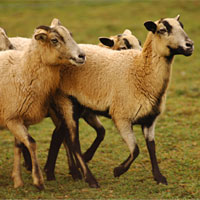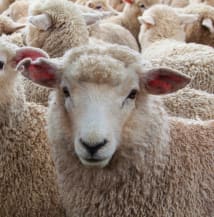
What is unique about sheep? They play a prominent role in the Pesach story and its commemorative commandments. Starting back in Egypt, G-d tells Moshe that each Jewish family should take a sheep and keep it in their care for four days before offering it as a sacrifice on the night of the Exodus. The blood of that sheep was what delineated a Jewish home from an Egyptian home, and was the symbol that G-d should “Pass over” that home while exacting vengeance on the Egyptian tormentors. That sheep’s blood indicated a difference between the house of a Jew and the house of his neighbor.
Throughout the periods of the Temple, every Jewish family traveled to Jerusalem and brought animals from the sheep family (artiodactyla bovidae in case you were wondering) as a Pesach offering, reliving the experience of our forefathers in Egypt. Even in 2008, while we sit at our seders, the roasted shank-bone on the seder plate is there to remind us of the sheep that were used as Pesach offerings. What is it about the sheep that is so central to the Pesach experience?
Even before the sheep was brought by the Jews as offerings, they had a prestigious role in Egyptian society. They were worshipped by the Egyptians as gods. Clearly, part of the significance of the Jews slaughtering of sheep was a sign of rejecting the idol-worship, but is there something deeper here as well?
The Egyptians were by no means a primitive society. The construction of the pyramids was a feat that even today, with modern technology, would be difficult. This is highlighted by the accuracy with which they were constructed. The great pavement, which surrounds the Great Pyramid and upon which it partially rests, is flat to within 15 mm. Many of the pyramids are aligned with stars and true North with extreme precision. The Ancient Egyptians were performing brain surgery thousands of years ago, and they also led the world in art, literature, and mathematics. How could they be so foolish as to bow down to a sheep? Did they really think the sheep created them, ran their world, and controlled their crops?
When the Egyptian bowed down to the sheep, he was showing that he worshipped a specific concept embodied in the sheep. He felt he should subjugate himself to that concept and try to live by it, and therefore bowed before that which represented it in physical form.
The sheep, more than any other animal, manifest the herd mentality. A shepherd only needs to find the “leader sheep” and make sure it goes where he wants it to, and the rest of the herd will follow. On July 8, 2005, the villagers of Gevas, Turkey saw this firsthand when over fifteen hundred sheep walked off a cliff simply because they were following the first one. (Only 450 of them died, the other’s falls were cushioned by the pile of sheep at the bottom of the cliff.)
The Egyptian people, advanced as they might have been, believed on living life with moral and spiritual blinders. They felt that stopping to assess one’s spiritual compass, examining one’s actions to determine if you are doing the right thing or if you are about to walk off a spiritual cliff was a negative. It was a drag on the conscience, it challenged one’s comfort zone, and it could even necessitate an entire lifestyle makeover. They therefore worshipped the sheep which is an exemplar of plodding along, following whatever everyone else is doing. This is seen most clearly by the Egyptian’s refusal to let the Jews go, even after a number of miraculous and painful plagues. No matter what happens, the Egyptians just forged forward into the abyss. Pharaoh even tried to force this lifestyle on the Jews by working them so hard that they would have no time to stop and think.
The Jewish people’s redemption was that they learned a new reality. They learned to reject mindless following, and to be a nation that constantly re-evaluates, re-programs, and receives direction from the Ultimate Source. Following G-d’s directive in taking the sheep and slaughtering it, epitomized this rejection and made their houses worthy of being passed over.
Throughout the temple era, Jews would trek to the Temple each Pesach, where they would bring the sheep offering, once again affirming their commitment not to simply follow the herd, but to choose that which is right, to choose the way that G-d mapped out for us in His Torah.
Today, in 2008, as we sit down at our seder tables, adorned with a shank-bone that represents that same sheep, lets see deeper than the roasted meat. Let’s see a calling for taking stock, for stopping to think, for looking beyond the blinders. In this way we can align ourselves to our ancestors, and experience our own personal exodus.
Leiby Burnham, LMSW, is a rabbi, psychotherapist, and writer. He lives in Detroit with his wife, an ICU nurse, who is on strict orders to “leave her patients at work” and their two daughters, Orah and Shifra. Rabbi Burnham works for the Jean and Theodore Weiss Partners in Torah program of Yeshiva Beth Yehudah, where he does community outreach, and runs a Jewish educational programs at University of Michigan, Wayne State, and Oakland University. He taught learning-disabled high school students for eight years in NYC, while receiving Rabbinical training at Shor Yoshuv Institute, and obtaining his Masters in Social Work from Yeshiva University.
The words of this author reflect his/her own opinions and do not necessarily represent the official position of the Orthodox Union.

